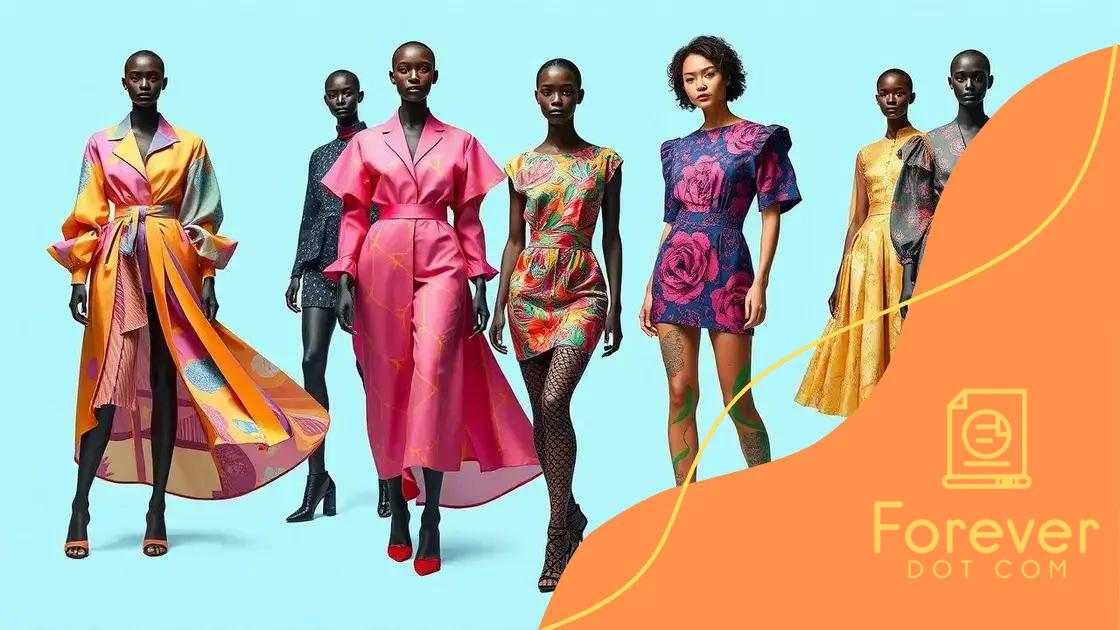Fashion collaborations with AI artists redefine style

Fashion collaborations with AI artists integrate technology and creativity, enabling personalized designs, enhancing sustainability, and driving innovative trends in the fashion industry.
Fashion collaborations with AI artists are changing the way we perceive style and creativity. Have you ever wondered how artificial intelligence can influence fashion design? Let’s dive into this fascinating intersection and explore its impact.
What are fashion collaborations with AI artists?
Fashion collaborations with AI artists have emerged as a revolutionary trend in the creative industry. These partnerships combine the innovative capabilities of artificial intelligence with human creativity, resulting in unique and compelling fashion pieces.
To better understand this phenomenon, it’s essential to explore the nature of these collaborations and what they entail.
Understanding Fashion Collaborations with AI
The collaboration between fashion designers and AI is a fascinating blend of technology and art. Designers harness algorithms to generate new designs, patterns, and styles. This process allows for a vast range of possibilities, pushing the boundaries of traditional fashion.
- AI can analyze current trends and consumer preferences.
- It generates designs based on specific parameters set by the artist.
- Collaboration can bring diverse cultural influences into the design process.
By using AI, designers not only boost their creative potential but also save time and resources. This shift encourages experimentation with materials and styles that might have previously been overlooked.
The Role of Technology in Fashion
The role of technology in the fashion industry is increasingly crucial. AI tools can predict future trends, offering insights that allow brands to stay ahead in a competitive market. For instance, digital fashion shows, powered by AI, can simulate the effects of various clothing designs in real-time.
- AI enhances the customization of fashion items for individual clients.
- It provides sustainable options by optimizing fabric usage.
- Trends can be analyzed swiftly, helping designers to make informed decisions.
This innovative approach not only improves the efficiency of the design process but also opens up new avenues for creativity. The fusion of human intuition and machine learning is indeed a game changer in the fashion world.
Benefits of AI involvement in the fashion industry
The benefits of AI involvement in the fashion industry are numerous and transformative. Designers are finding innovative ways to integrate technology into their creative processes. This blend enhances both efficiency and creativity in fashion design.
Efficiency and Speed
One of the most significant advantages is the increase in efficiency. AI algorithms can analyze vast amounts of data quickly, revealing trends and consumer preferences in real time. Designers can react faster to market changes, producing collections that resonate with customers.
- AI tools help streamline the design process.
- They reduce the time spent on repetitive tasks.
- Automating production schedules enhances overall productivity.
By utilizing these technologies, brands can adapt to shifts in the market promptly. It leads to timely launches and ultimately, better sales outcomes.
Enhanced Creativity
AI also contributes to enhanced creativity in fashion design. With machine learning, systems can generate unique design options based on existing trends, giving designers a wealth of inspiration. This collaboration sparks new ideas that may not have surfaced independently.
- AI can suggest color palettes based on current styles.
- It can combine elements from diverse cultures effortlessly.
- Designers can explore unconventional materials through AI insights.
The enriching relationship between human creativity and machine intelligence fosters an environment where innovative designs flourish. This ensures the fashion industry remains dynamic and forward-thinking.
Notable examples of successful collaborations

Many notable examples of successful collaborations between fashion brands and AI artists illustrate the power of technology in transforming the fashion landscape. These partnerships showcase the potential of AI to create stunning and innovative designs that resonate with consumers.
Collaboration Case Studies
One significant example is the collaboration between the fashion label Gucci and an AI tool known as DeepArt. This partnership resulted in a unique exhibition that allowed artists and designers to explore styles generated by AI based on existing Gucci patterns. The outcome generated excitement among consumers and showcased how AI could enhance artistic expression.
- The partnership highlighted AI’s role in fine arts and fashion.
- It drew attention to how technology can inspire traditional artisans.
- The event increased public interest in both the fashion and tech industries.
Another prominent instance is the work of Balenciaga with AI-generated designs. The brand featured clothing produced using AI algorithms during fashion week. These pieces were not only eye-catching but also sparked conversations about the future of fashion.
Impact on Consumer Engagement
These collaborations have a profound impact on consumer engagement. By merging strong brand identities with cutting-edge technology, brands attract tech-savvy customers who value innovation. AI-generated fashion collections often create buzz on social media, further enhancing brand visibility.
- Innovative designs encourage discussions among fashion enthusiasts.
- Brands can tap into new demographics interested in fashion technology.
- Successful collaborations create a sense of community among fans and followers.
All in all, these collaborations show that the union of fashion and AI not only creates remarkable designs but also ignites excitement and interest in both fields. The possibilities are endless as more brands explore this creative path.
Challenges faced in blending art and technology
Blending art and technology in fashion brings exciting possibilities, but it also presents several challenges faced in blending art and technology. These challenges can impact how effectively designers use AI as a creative tool.
Understanding the Complexities
One significant challenge involves the interpretation of artistic vision. AI can analyze data and generate designs, but it lacks the emotional understanding that human artists bring to their work. This gap can lead to creations that miss the intended artistic context.
- AI-generated designs may not always align with the designer’s brand identity.
- The subtlety of human emotion in art is difficult for machines to replicate.
- AI might produce variations that are too far from artistic intent.
Furthermore, resistance from traditional artists and designers can hinder acceptance of AI tools. Many creatives fear that their work may be devalued by automated processes. This concern can prevent collaboration between artists and technologists, stifling opportunity for innovation.
Ethical Considerations
Ethical considerations also play a crucial role in this blend. Issues regarding authorship and ownership of AI-generated designs can create tensions in the industry. Questions arise about who should be credited for the artwork— the designer who input the parameters or the AI itself that created the actual design.
- Copyright laws may not adequately address AI contributions.
- Disputes can arise over the use of existing designs in AI training data.
- The fashion industry may need new frameworks for collaboration.
These challenges highlight the need for careful navigation as fashion brands embrace AI technology. Balancing creativity with technological advancement is an ongoing journey that requires dialogue and collaboration among artists, technologists, and consumers.
Future trends in fashion and AI partnerships
The future trends in fashion and AI partnerships promise to shape the industry in exciting ways. As technology continues to evolve, the integration of AI into fashion design is expected to deepen, paving the way for a new era of creativity and innovation.
Personalization and Customization
One key trend is the rise of personalization. With AI, brands can analyze consumer data to create tailored fashion experiences. This means that designs can be customized to fit individual tastes and preferences. Imagine a world where your clothing fits your style perfectly and is made just for you.
- AI algorithms can learn from shopping habits and suggest items.
- Customization options allow consumers to select colors and patterns.
- Enhanced customer profiles can lead to improved marketing strategies.
This level of personalization not only enhances consumer satisfaction but also builds brand loyalty. As customers receive products that reflect their unique identities, they are more likely to develop lasting relationships with brands.
Exploring Sustainability
Sustainability also stands at the forefront of future trends. AI has the power to optimize supply chains and reduce waste. By predicting demand, brands can manage inventory more effectively, minimizing overproduction and its environmental impact.
- AI can analyze trends and forecast popular items accurately.
- Brands can adopt sustainable materials based on AI analysis.
- Computer-generated designs help in reducing fabric waste.
In this way, combining AI with sustainable practices can lead to a more responsible fashion industry. Future collaborations will likely explore these possibilities even further, encouraging a shift towards eco-friendly approaches.
As technology improves, we can also expect new forms of fashion shown through virtual experiences. Imagine trying on clothes in virtual reality or experiencing a digital fashion show in your own living room. The merging of physical and digital realms will create innovative platforms for showcasing fashion.
In conclusion, the integration of AI in the fashion industry is paving the way for innovative designs, personalized experiences, and sustainable practices. As brands continue to explore this synergy, we can expect to see exciting new trends that reshape how we experience fashion. The partnership between art and technology not only enhances creativity but also addresses important issues like sustainability. Embracing these changes will allow the fashion industry to thrive in a rapidly evolving world. With each collaboration, we step closer to a future where fashion is more accessible, responsible, and transformative.
FAQ – Frequently Asked Questions about Fashion Collaborations with AI Artists
What benefits do AI partnerships bring to the fashion industry?
AI partnerships enhance creativity, enable personalization, and promote sustainability, resulting in more innovative and eco-friendly designs.
How does AI improve consumer engagement in fashion?
AI analyzes consumer data to provide personalized recommendations, creating clothing experiences that resonate with individual preferences.
What challenges do brands face when implementing AI in fashion?
Brands encounter challenges such as interpreting artistic vision, ethical considerations of authorship, and potential resistance from traditional artists.
What future trends should we expect in fashion and AI partnerships?
Future trends include increased personalization, sustainable practices, and virtual experiences, making fashion more dynamic and interactive.






